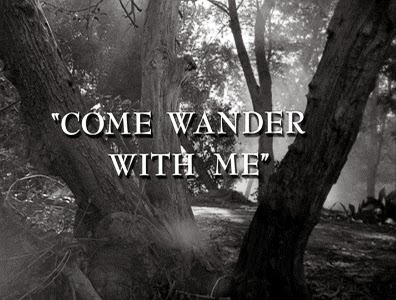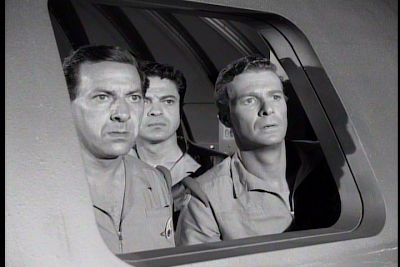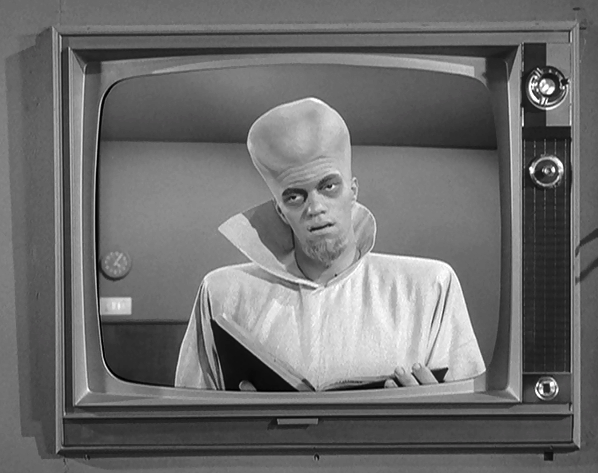There are, perhaps, several episodes of Rod Serling's classic The Twilight Zone (1959-1964) more sharply-written, more morally-valuable, and more resonant in a simple, emotional sense than "Come Wander with Me." Many Twilight Zone segments also boast superior twist endings.
Simply stated, "Come Wander With Me" casts a hypnotic spell.
"Come Wander With Me" was the final episode of The Twilight Zone filmed/produced for CBS, and the third-to-last episode to air on that network in prime time. It premiered on May 22, 1964 and dramatized the tale of Floyd Burney (Gary Crosby), the so-called "Rock-a-Billy Kid."
Burney is a cocky but insecure "celebrity," an up-and-coming music star without the slightest sense of originality, individuality or artistry. As the episode begins, Burney has arrived at the foothills of Appalachia in hopes of "stealing" a song from the naive locals there and "conjuring" another hit to augment his singing career. He justifies this act of creative theft by noting that all the folk-music stars of the day do it...
This narrative set-up mirrors a real-life context of the times. From the 1950s-to-early 1960s, there was a folk music revival movement in the U.S., one in which a wide variety of artists imported the fiddle and banjo-style of Appalachian folk songs (often ballads...) from remote, poverty-stricken Appalachia into the nation's musical mainstream.
This local music style proved increasingly popular -- especially as the Beatnik "coffeehouse" movement came to life -- but so did the notion of Appalachia as a backward, violent, isolated realm of cultural separation and inscrutable mystique.This geographical region in the South East U.S. became increasingly feared and derided because of popular stereotypes; for the sense of it as a setting of oppressive fundamental religion and...ghost stories.
In "Come Wander with Me," we see such a world-view fully articulated.This Appalachia is a dangerous, foreign place that doesn't conform to the "rules" of life as Burney understands them. In other words, cash isn't God; and actions (such as pre-marital sex...) have consequences. And far from being an authentic musician (or even boasting a particularly "Up with People" attitude...) Floyd Burney is but a slick, self-centered celebrity looking simply to steal a resource. Even his car is gaudily decorated with the titles of his insipid hit songs. We recognize immediately that he's out-of-his-element...and playing with fire.
There's a great visual touch that inaugurates "Come Wander with Me." As Burney stops his car at the foot of a rickety, damaged bridge, we can see that a floorboard is missing directly ahead. So Burney exits his car, and steps over that gulf himself, unawares.
That missing plank in the bridge, however, is the specific demarcation point between reality and the supernatural; between the American mainstream and isolated Appalachia. And, as Rod Serling would no doubt declare, it's our point-of-entrance into...The Twilight Zone.
Once in the woods, the hungry, exploitative Burney begins hunting for his "new" song. He tells a gargoyle-esque junk/music shop owner "Anything you got is PD - public domain! You've got no rights!" and then graciously (!) offers to buy the old man's songs for a meager handful of cash. The local declines to help, but Burney refuses to relent...until he hears a recurrent, eerie melody emanating from somewhere deep within the forest ahead.
Burney passes into a heavy mist as he treads deeper into the seemingly-endless woods, and is so consumed with his mission that he misses something important nearby: his own grave-stone, jutting roughly out of the Earth.
As Burney goes in search of the obsessive melody, he misses something else too. In at least two separate shots, we detect a mystery figure shrouded in black...reaching out for him in the distance. This apparition appears in the background of the frame (as Burney hunts in the foreground...), and the long-shot, deep-focus composition crafted by Donner is creepy as hell. Because the figure is at first stationary -- and almost camouflaged -- we don't see it right off the bat amid the ancient woods. When we do see it, we're startled.
This Life and the After-Life have merged...
Burney soon discovers that the source of the song is an innocent young woman, Mary Rachel (Bonnie Beecher). This siren is beautiful, a bit sad, and all-together reluctant to sing Burney the entire song.
Ever the smooth operator, Burney romances Mary Rachel, even though she's already "be-spoke" to a local gent named Billy Rayford. Successfully taken-in by promises of a life with Burney, Mary Rachel finally reveals the melancholy song in its apparent entirety: a haunting, timeless composition by Jeff Alexander, called, appropriately, "Come Wander with Me."
As the song is repeated -- and as Floyd and Mary Rachel consummate their relationship 'neath an old willow tree -- the episode cuts to another montage that seems to fracture time: a series of progressive zooms leading into crisp dissolves. The zooms always draw us nearer to the intermingled duo (sometimes from doom-laden high angles). It's as though Fate itself has locked them in its cross-hairs.
"It can't be bought," Mary Rachel counters, but Burney doesn't understand what she means.
Then a jealous Billy Rayford shows up -- a man with the odd, shambling gait and blind, lifeless stare of the living dead. There's a scuffle, and Burney (too easily, perhaps...) kills him.
In fact, as Billy's brothers relentlessly hunt down Floyd Burney to avenge the death of their kin, Mary Rachel's song continues to morph and grow, adding new, more disturbing verses all the time.
Mary Rachel begs Floyd not to run "this time," but he does it anyway. As he flees, he sees Mary Rachel once more, now garbed in black...a mourner at his grave.
And when the Rayfords finally come for Floyd, we never actually see them as human beings. Rather, they are suggested as inhuman Furies. They are depicted as long black shadows which stretch malevolently across the ground, and then, finally, eclipse the light over Floyd Burney's terrified face...
What "Come Wander with Me" circumscribes, however, is truly a vicious circle. A cycle without end and without beginning, very much like a song being composed before our eyes and ears. If we could ever truly feel what it likes to be trapped inside a song -- inside a personal melody -- I have the feeling it would seem just like "Come Wander with Me" because the story is graced with a sense of the inevitable, the inescapable.
And the main character, Floyd Burney, has already been "conceived" or "imagined" by the composer as the subject of this tune, and therefore cannot change his path, his destiny, his crescendo. He will always be the Rock-A-Billy Kid...the one who trespassed (by stealing a song and a woman...), and who paid with his life. The song tells us who he is; and he can never change because those verses are already written and sung. The song which can't be bought...defines him. He already "owns" it.
Or it owns him.
The less-important supporting characters, like the doomed Billy Rayford, are barely "human" at all. They are merely ciphers -- musical notes, perhaps -- who help bring the song round to its final stanza. As Mary Rachel explains, they do only what is expected of them. "He always comes here," she says, in regards to Billy. He has no choice in the matter, because this isn't his song...it's Floyd's.
If you remember the story of Sisyphus, you might recognize "Come Wander with Me" as something more than a never-ending song.
It's also a personal Hell for Floyd Burney (meaning, perhaps, that it occurs after his mortality ends, in Hell itself).
Just as Sisyphus's punishment was to always push a rock up a hill, only to see it roll back down, and have to start over, our Floyd Burney must likewise re-live -- again and again -- the avaricious song hunt (and personal manipulation of Mary Rachel) that led him to his trespass and demise.
In each refrain of the song (and of his personal Hell...) Mary Rachel begs Floyd to change his course (to hide, rather than run...) but Floyd is stuck in a rut -- like a record repeating on the same groove again and again. Even Fate (or is the Devil?) is seemingly against Floyd: when he returns to the junk music store to hide, all the musical instruments come miraculously to life to reveal his position to the Rayfords.
And, finally, when Burney states that he has "come too far, too fast to be buried in Sticksville," I wondered if he meant, perchance Styx-ville.
There's a majestic sweep, and subtle, cerebral horror underlining "Come Wander with Me." The song was deployed to similar haunting effect in Vincent Gallo's 2003 film, Brown Bunny. Several contemporary bands have covered the tune too, and it even appeared in a Dutch insurance commercial in 2006.
But for me, it's virtually impossible to separate "Come Wander with Me" from Bonnie Beecher, Floyd Burney's personal hell, Applachia, or this unique, brilliantly-crafted episode of The Twilight Zone.
This is a song (and an episode) you just can't get out of your head.
































